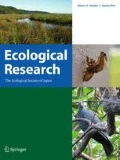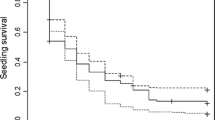Seedling densities and the mortality of fleshy-fruited species under 10 European tall-shrub species and the tree Sorbus aria were analyzed in 10-year-old experimental scrub for one growing season. The mean total densities of seedlings of 18 fleshy-fruited species differed under the different ‘hosts’, being highest under Crataegus monogyna, Viburnum opulus and Rosa canina (24–20 m−2); intermediate under Sorbus aria, Rhamnus catharticus, Cornus sanguinea, Ligustrum vulgare and Juniperus communis (17–12 m−2); and lowest under Euonymus europaeus, Viburnum lantana and Prunus spinosa (10–9 m−2). This ranking was similar for the 11 planted species and for nine bird-dispersed, non-planted species which invaded the site, notably Hedera helix and Solanum dulcamara. Within the experimental scrub as a whole mortality of seedlings differed significantly among species, being highest in those with the smallest number of recruits. Mortality ranged from 94% and 89% for Solanum dulcamara and Viburnum opulus to 26% for Hedera helix and Ligustrum vulgare. The mean mortality across all species of seedlings did not differ significantly between host species, although it was slightly higher under Juniperus and Cornus (56%, 53%) and lower under Viburnum lantana and Rhamnus (42%, 41%). In four species, the mortality of seedlings was significantly higher under conspecific adults. Mean topsoil water content after a dry spell was negatively correlated with the diffuse site factor (DSF). The mean density of accumulated seedlings of the most abundant seedling species (Hedera) was positively correlated with the topsoil water content. Densities of other species showed no strong correlations with either topsoil water content or DSF. The probable factors controlling recruitment are discussed.
Similar content being viewed by others
REFERENCES
Anderson, M. C. (1964a) Studies of the woodland light climate. I. The photographic computation of light conditions. Journal of Ecology 52: 27--41.
Anderson, M. C. (1964b) Light relations of terrestrial plant communities and their measurement. Biological Reviews 39: 425--486.
Becker, P., Rabenhold, P. E., Idol, J. R. & Smith, A. P. (1988) Water potential gradients for gaps in a Panamanian tropical moist forest’s dry season. Journal of Tropical Ecology 4: 173--184.
Berkowitz, A. R., Canham, C. D. & Kelly, V. R. (1995) Competition vs. facilitation of tree seedling growth and survival in early successional communities. Ecology 76: 1156--1168.
Breshears, D. D., Myers, O. B., Johnson, S. R., Meyer, C. W. & Martens, S. N. (1997) Differential use of spatially heterogeneous soil moisture by two semiarid woody species: Pinus edulis and Juniperus monosperma. Journal of Ecology 85: 289--299.
Burton, P. J. & Bazzaz, F. A. (1995) Ecophysiological responses of tree seedlings invading different patches of old-field vegetation. Journal of Ecology 83: 99--112.
Debussche, M., Escarré, J. & Lepart, J. (1982) Ornithochory and plant succession in Mediterranean abandoned orchards. Vegetatio 48: 255--266.
Debussche, M. & Isenmann, P. (1989) Fleshy fruit characters and the choices of bird and mammal seed dispersers in a Mediterranean region. Oikos 56: 327--338.
Debussche, M. & Isenmann, P. (1994) Bird-dispersed seed rain and seedling establishment in patchy Mediterranean vegetation. Oikos 69: 414--426.
Denslow, J. S. & Moermond, T. C. (1982) The effect of accessibility on rates of fruit removal from tropical shrubs: an experimental study. Oecologia 54: 170--176.
Dowdeswell, W. H. (1987) Hedgerows and Verges. Allen and Unwin, London.
Eber, W. (1972) Über das Lichtklima von Wäldern bei Göttingen und seinen Einfluß auf die Boden-vegetation. Scripta Geobotanica 3: 1--150.
Ellenberg, H. (1988) Vegetation Ecology of Central Europe. Cambridge University Press, Cambridge.
Fuentes, M. (1994) Diets of fruit-eating birds: what are the causes of interspecific differences? Oecologia 97: 134--142.
Grubb, P. J., Lee, W. G., Kollmann, J. & Wilson, J. B. (1996) Interaction of irradiance and soil nutrient supply on growth of seedlings of ten European tall-shrub species and Fagus sylvatica. Journal of Ecology 84: 827--840.
Herrera, C. M. (1984) Seed dispersal and fitness determinants in wild rose: combined effects of hawthorn, birds, mice, and browsing ungulates. Oecologia 63: 386--393.
Herrera, C. M. (1987) Vertebrate-dispersed plants of the Iberian peninsula: a study of fruit characteristics. Ecological Monographs 57: 305--331.
Herrera, C. M., Jordano, P., López-Soria, L. & Amat, J. A. (1994) Recruitment of a mastfruiting, bird-dispersed tree bridging frugivore activity and seedling establishment. Ecological Monographs 64: 315--344.
Izhaki, I., Walton, P. B. & Safriel, U. N. (1991) Seed shadows generated by frugivorous birds in an eastern Mediterranean scrub. Journal of Ecology 79: 575--590.
Joffre, R. & Rambal, S. (1993) How tree cover influences the water balance of Mediterranean rangelands. Ecology 74: 570--582.
Key B. A. (1979) Soil enrichment under chalk scrub and re-establishment of chalk grassland after scrub clearance. PhD thesis, University of Cambridge.
Kollmann, J. (1994) Ausbreitungsökologie endozoochorer Gehölzarten. Veröffentlichungen PAÖ 9: 1--212.
Kollmann, J. (1995) Regeneration window for fleshy-fruited plants during scrub development on abandoned grassland. Ecoscience 2: 213--222.
Kollmann, J., Coomes, D. A. & White, S. M. (1998) Consistencies in post-dipersal seed predation of temperate fleshy-fruited species among seasons, years and sites. Functional Ecology 12: 683--690.
Kollmann, J. & Pirl, M. (1995) Spatial pattern of seed rain of fleshy-fruited plants in a scrubland-grassland transition. Acta Oecologica 16: 313--329.
Kollmann, J. & Reiner, S. A. (1996) Light demands of shrub seedlings and their establishment within scrublands. Flora 191: 191--200.
Küppers, M. (1985) Carbon relations and competition between woody species in a central European hedgerow. IV. Growth form and partitioning. Oecologia 66: 343--352.
Küppers, M. (1992) Changes in plant ecophysiology across a central European hedgerow ecotone. In: Landscape Boundaries (eds A. J. Hansen & F. di Castri) pp. 285--303. Springer, Berlin.
Lee, W. G., Grubb, P. J. & Wilson, J. B. (1991) Patterns of resource allocation in fleshy fruits of nine European tall-shrub species. Oikos 61: 307--315.
McDonnell, M. J. (1986) Old field vegetation height and the dispersal pattern of bird disseminated woody plants. Bulletin of the Torrey Botanical Club 113: 6--11.
Milton, S. J., Dean, W. R. J. & Klotz, S. (1997) Thicket formation in abandoned fruit orchards: processes and implications for the conservation of semi-dry grasslands in Central Germany. Biodiversity and Conservation 6: 275--290.
Moro, M. J., Pugnaire, F. I., Haase, P. & Puigdefábregas, J. (1997) Mechanisms of interaction between leguminous shrub and its understorey in a semi-arid environment. Ecography 20: 175--184.
Parent, S. & Messier, C. (1996) A simple and efficient method to estimate microsite light availability under a forest canopy. Canadian Journal of Forest Research 26: 151--154.
Putz, F. E. & Canham, C. D. (1992) Mechanisms of arrested succession in shrublands: root and shoot competition between shrubs and tree seedlings. Forest Ecology and Management 49: 267--275.
Reid, N. (1989) Dispersal of mistletoes by honeyeaters and flowerpeckers: Components of seed dispersal quality. Ecology 70: 137--145.
Reif, A. & Aulig, G. (1990) Neupflanzung von Hecken im Rahmen von Flurbereinigungsmaßnahmen: Ökologische Voraussetzungen, Historische Entwicklung der Pflanzkonzepte sowie Entwicklung der Vegetation gepflanzter Hecken. Berichte Akademie Naturschutz und Landschaftspflege 14: 185--220.
Robberecht, R., Mahall, B. E. & Nobel, P. S. (1983) Experimental removal of intraspecific neighbours--effects on water relations and productivity of a desert bunch-grass Hilaria rigida. Oecologia 60: 21--24.
Robinson, G. R. & Handel, S. N. (1993) Forest restoration on a closed landfill: rapid addition of new species by bird dispersal. Conservation Biology 7: 271--278.
Rodwell, J. S. (ed.) (1991) British Plant Communities, Vol. I. Woodlands and Scrub. Cambridge University Press, Cambridge.
Sallabanks, R. (1993) Hierarchical mechanisms of fruit selection by an avian frugivore. Ecology 74: 1326--1336.
Schupp, E. W. (1993) Quantity, quality, and the effectiveness of seed dispersal by animals. In: Frugivory and Seed Dispersal: Ecological and Evolutionary Aspects (eds T. H. Fleming & A. Estrada) pp. 15--29. Kluwer, Dordrecht.
Schupp, E. W. (1995) Seed-seedling conflicts, habitat choice, and patterns of plant recruitment. American Journal of Botany 82: 399--409.
Slavíková, J. (1958) Einfluß der Buche (Fagus silvatica L.) als Edifikator auf die Entwicklung der Krautschicht in Buchenphytocönosen. Preslia 30: 19--42.
Snow, B. & Snow, D. (1988) Birds and Berries. Poyser, Calton.
Sorensen, A. E. (1981) Interactions between birds and fruit in a temperate woodland. Oecologia 50: 242--249.
Streng, R. D., Glitzenstein, J. S. & Harcombe, P. A. (1989) Woody seedling dynamics in an East Texas floodplain forest. Ecological Monographs 59: 177--204.
Tilman, D. (1988) Plant Strategies and the Dynamics and Structure of Plant Communities. Princeton University Press, Princeton, NJ.
Tutin, T. G., Heywood, V. H., Burges, N. A., Valentine, D. H., Walters, S. M. & Webb, D. A. (1964--1980) Flora Europaea, Vol. 1--5. Cambridge University Press, Cambridge.
Veenendaal, E. M., Swaine, M. D., Agyeman, V. K., Blay, V. K. D., Abebreese, I. K. & Owusu-Afriye, K. (1996) Differences in plant and water relations in and around a forest gap in West Africa during the dry season may influence seedling establishment and survival. Journal of Ecology 84: 83--90.
Vitousek, P. M. & Denslow, J. S. (1986) Nitrogen and phosphorus availability in treefall gaps of a lowland tropical rainforest. Journal of Ecology 74: 1167--1178.
Winkler, H. & Leisler, B. (1986) Morphological aspects of habitat selection in birds. In: Habitat Selection in Birds (ed. M. L. Cody) pp. 415--434. Academic Press, Orlando, FL.
Zar, J. H. (1996) Biostatistical Analysis. Prentice Hall, Upper Saddle River.
Author information
Authors and Affiliations
Corresponding author
About this article
Cite this article
Kollmann, J., Grubb, P. Recruitment of fleshy-fruited species under different shrub species: Control by under-canopy environment. Ecol Res 14, 9–21 (1999). https://doi.org/10.1046/j.1440-1703.1999.141281.x
Received:
Accepted:
Issue Date:
DOI: https://doi.org/10.1046/j.1440-1703.1999.141281.x




